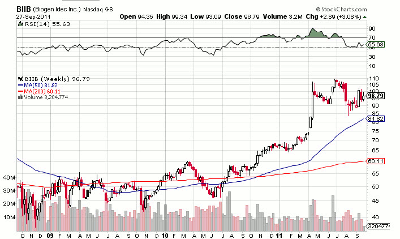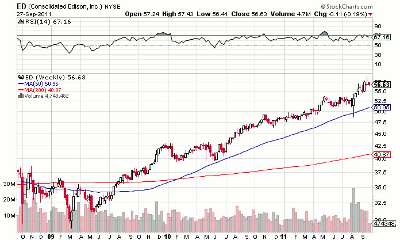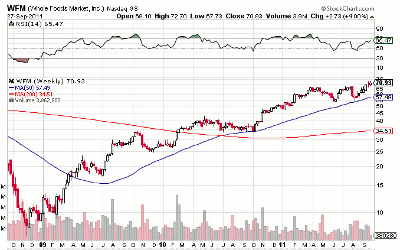The best-performing S&P sectors boast some stocks that have fared well, even throughout the volatile market conditions of recent months, writes MoneyShow.com contributor Kate Stalter.
Within the S&P 500, only three sectors are showing year-to-date gains: Health care, utilities, and consumer staples. All of these, which could be collected under the umbrella of “defensives,” are in positive territory for 2011, although they’ve wavered in recent weeks.
Even so, there are standouts within those sectors. Biogen Idec (BIIB), a biotech that develops treatment for cancer, multiple sclerosis and autoimmune conditions, has a chart that caught my attention. The S&P 500 component is consolidating gains after retreating from an all-time high in June.
I often track stocks that appear to be carving the right side of a base, and Biogen Idec fits that bill. The stock, like many others, suffered heavy-volume declines in the first half of August, when the broader market sold off.
Even in its recent pullback, it’s continued to find support above its 40-week average, and is currently trading above its ten-week line as it attempts to rally higher. Its all-time high was $109.63, reached in June. Shares are now trading about 11% below that high, and about 17% above its intermediate low of $83.83 from August 9.
For the next few weeks, watch for heavy trading volume if the stock is able to continue clawing its way higher. In the general market’s risk-on rally in recent sessions, Biogen Idec has risen in below-average trade. Higher volume would be a better sign of conviction among institutional investors.
The company is expected to deliver its next earnings report in late October. Watch the stock’s action in the weeks leading up to the report, to see how investors and traders are valuing shares, and whether they are buying or selling in heavy volume.
Turning to another leading sector, utilities are not typically of much interest in most bull markets. But in the volatile conditions we’ve been experiencing, utilities have provided a safe harbor for investors seeking some stability in their portfolios, along with a dependable dividend yield.
However, if the nascent market rally takes hold, utilities could lose their appeal as growth names take the lead.
For now, Consolidated Edison (ED), the electrical utility in the New York area, as well as in other Northeastern states, has been making slow and steady price progress above its ten-week moving average.
It’s now trading in new high ground, an area where many investors lose interest, believing it’s too late. However, stocks that rally to fresh highs are worth tracking, to see when they offer a buy opportunity on a subsequent pullback.
The earlier price action is a positive sign, showing that institutions have conviction about the stock. If it pulls back and holds near its ten-week moving average, it may be a technical buy candidate.
There have been some weeks of heavy upside volume, as investors piled into the stock as a respite from more volatile equities. Con Ed’s current dividend yield is 4.2%.
|pagebreak|The consumer staples sector, while historically a defensive play, is home to the occasional fast-grower. Whole Foods (WFM), which along with Biogen Idec and Con Ed is a benchmark index component, has, at various times in its history, posted better-than-average fundamentals and technicals.
The stock is trading at five-year highs, and earnings have grown at a rate of 23% or higher during each quarter of the past two years.
The stock’s chart has exhibited some potentially bullish characteristics lately. It attempted to clear a price consolidation this summer, but amid general market malaise, was unable to gain upside traction.
Whole Foods retreated into a new base in August, as the major indices went into free fall. This time, the low of the formation undercut—by 60 cents—the low of the prior consolidation. That’s a good sign, an indication that perhaps weak holders had finally been flushed out, setting the stage for fresh gains.
Indeed, that’s what happened, as the stock definitively cleared its previous price resistance, above $68, in heavy volume on September 15. It’s held well above its ten-week line since then, while exhibiting some choppy trade that’s reflective of the general market.
The company is expected to report its fourth quarter on or around November 2, with earnings seen coming in at 41 cents per share. That would be a 24% year-over-year gain. Revenue is expected to come in at $2.36 billion, up 17% from a year ago.
I like to track revenue reports along with earnings, to ascertain that EPS increases are due to increased customer demand, not cost cutting. In Whole Foods’ case, sales have risen at double-digit rates in the past six quarters, a good sign of strength.
To some, it might seem counterintuitive that a natural-foods grocer, widely seen as pricey, would be notching strong gains in a weak economy. After all, this is the store that’s known by the facetious moniker “Whole Paycheck.”
However, upscale consumers continued shopping at the company’s stores. At the same time, Whole Foods renewed its focus on its store brand, 365, with offerings at prices comparable to those in other major grocery chains.
This is another example where I’ll be watching the stock for its next pullback, and tracking the price and volume activity as the next earnings report approaches.
At the time of publication, Kate Stalter did not hold positions in any of the stocks mentioned in this column.













